Mammotion Luba Review: Our Experience with the RTK Robot Mower Luba AWD 3000 by Mammotion
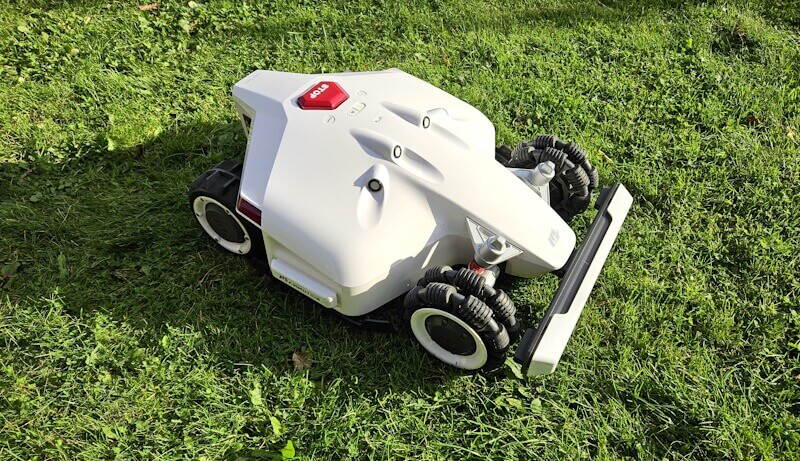
UPDATE: Successor Mammotion Luba 2 unveiled
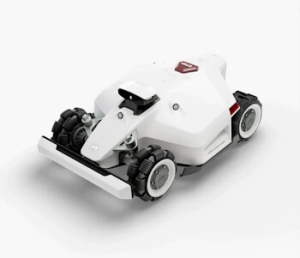
Especially in narrow passages near buildings or walls, and under roofs and large trees, the RTK system often reaches its technical limits and can no longer provide accurate positional data. The Luba 1 was therefore not designed for such conditions, but this changes with the successor. Here, the so-called 3D Vision camera system, which generates spatial perception through two independent lenses, complements the navigation of the Luba robotic mower, allowing it to continue its work temporarily even without an RTK signal.
Additionally, obstacle detection is expected to be significantly improved through the camera data combined with a deep-learning algorithm. Spatial vision thus supplements the existing ultrasonic sensors and sensors in the shock absorbers to form a three-layer redundant safety system. Obstacles should be reliably detected and avoided autonomously, even from just a few centimeters. The combination of RTK technology with optical data is forward-thinking and necessary to compensate for the weaknesses of both systems.
As additional features, the Mammotion Luba 2 includes an optional property surveillance with access to real-time camera data. Thus, the Luba 2 can also serve as a guardian for the home and yard. For those interested, symbols or messages can also be mowed into the lawn by the Luba. Compared to the Luba 1, the maximum slope for the Mammotion Luba 2 has increased to 80% (38°), and the cutting height is selectable between 25 and 70 mm (Standard Version) or 60 and 100 mm (H Version). Optionally, a solar module for the RTK station is offered, allowing it to be operated entirely regenerative. The existing three models for gardens up to 1000, 3000, or 5000 m² are complemented by a fourth model for gardens up to 10,000 m². Prices have slightly increased, which, given the new hardware and features, we consider appropriate.
» Check out the Mammotion Luba 2 AWD*
Overview: This is the Mammotion Luba
The Mammotion Luba is available in three variants, distinguished by the area they are designed to cover. The apparent technical difference lies mainly in the battery capacity. The smallest model, Luba AWD 1000, is suitable for areas up to 0.25 acres (1000 m²), the middle-sized Luba AWD 3000 for up to 0.75 acres (3000 m²), and the largest model, Luba AWD 5000, can handle gardens up to 1.25 acres (5000 m²). Prices for the models range from 1,799 to 2,599 dollars (RRP). This places it among robotic mowers intended more for medium to large gardens. Of course, it can also handle smaller gardens – the general rule being: the larger the area compared to your garden, the less wear and tear and the lower the frequency of mowing operations.
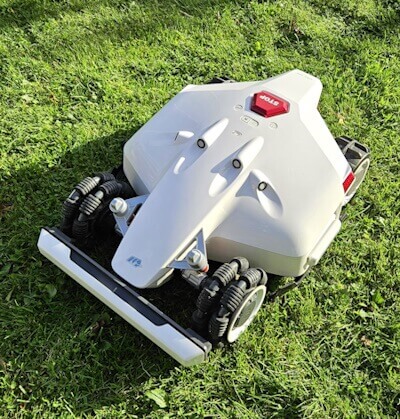
A real eye-catcher – the Mammotion Luba AWD
Furthermore, to protect wildlife and plant life, we always recommend choosing a robot mower with about 30% more capacity than necessary for your garden. Unsupervised operation during the evening or night hours should be avoided to protect hedgehogs and other nocturnal animals.
This applies to the Luba model as well, as its obstacle detection relies on the traditional collision sensor combined with ultrasonic sensors with a 220° field of view. Depending on the settings, they work well, but obstacles can only be detected at a height of 5 cm or more. The accuracy of these sensors can be adjusted in the app, and the ultrasonic sensors can also be completely turned off (menu item: Bypass Strategy). The advantage of this common configuration is that users are not tempted to overestimate the robot mower and let it operate entirely without control at any time of day or night.
Mammotion is a startup from 2022 with over 150 employees. According to their statements, they own numerous patents and have a large production base. The company’s goal is to offer robotic solutions for end consumers as well as professional users. Professional users can control multiple Luba 5000 units with one app, making it suitable for large areas such as football fields or golf courses.
In addition, the manufacturer offers a 30-day return policy, which is significantly longer than the legal norm. Video tutorials, lifelong customer support, and a two-year warranty on most components are also included. We did not delve into the customer support during our test (as it was not necessary), so we cannot make any statements about it. Additionally, there is a chatbot in the app that directs users to known questions and their corresponding answers.
Delivery Contents: Everything Necessary and a Little More
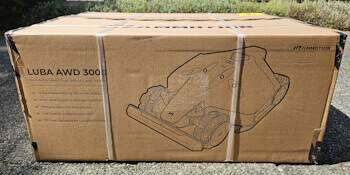
Sturdy packaging of the Mammotion Luba AWD 3000
Regarding the Mammotion Luba’s delivery contents, everything necessary for a successful start is included. In addition to the robotic mower itself, the package contains the charging station and the RTK antenna. All necessary cables, as well as extensions for optional expansions, are also included. A second set of blades is provided as well. The included installation guide is clear, and in our test, setup was quickly completed with its guidance. Nevertheless, we strongly recommend checking the comprehensive online user manual for a more in-depth understanding of how the Luba operates, including a more detailed explanation of the app’s functionality.
Also included is a power supply for the external power of the RTK antenna, allowing the antenna to be installed independently of the charging station. In handling the app, there are additional video tutorials on the Mammotion website available for viewing, along with the mentioned online user manual. What was not included in the delivery contents was a garage or shelter. This can be purchased additionally or easily built. Despite the Luba being waterproof, we recommend using a cover to protect it from all weather conditions. The Luba itself is relatively heavy, weighing over 20 kg, giving a robust impression right from unpacking.
The Technical Specs: What Can the Luba Do?
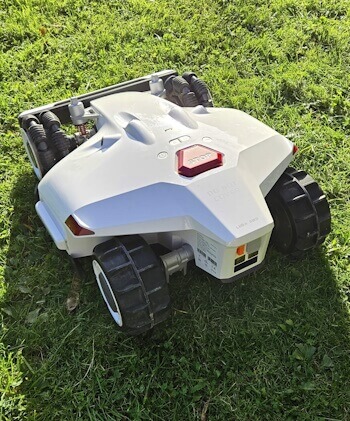
The powerful all-wheel drive performs well in testing
As mentioned earlier, the Mammotion is designed for gardens ranging from 0.25 to 1.25 acres (1000 m² to 5000 m²), with prices starting from 1,999 euros for the smallest model. This is notably higher than models that operate with a perimeter wire, but it is a common price range for this class of robotic mowers. It’s worth considering that many users prefer not to lay the perimeter wire themselves, in which case additional costs need to be factored in beyond the initial purchase price. This is not the case with the Luba, as there is no need for a perimeter wire or the potential costs associated with repairing or reinstalling it when making temporary changes to the mowing area.
The Mammotion Luba’s orientation is facilitated by GPS-based navigation and a virtual boundary of the working area, which we’ll delve into more precisely later on. An interesting feature is the Luba’s all-wheel drive, which is still relatively uncommon in current robotic mowers and enables a maximum slope of 65%, or 75% in the case of the largest model. Many other standard robotic mowers would have already failed on slopes of this steepness.
The Mammotion Luba is designed for multiple distinct lawn areas, featuring a so-called Multi-Zone function. Different lawn areas can be defined, along with passages between each area, allowing the Luba to autonomously move from one to the next. In the test, this function worked mostly flawlessly — only in complex passages that weren’t entirely outdoors did the Luba occasionally encounter issues, needing to turn back or remaining in place. More on this in the next section. Mowing areas or zones can be connected with passages, but don’t necessarily have to be. The number of supported zones varies among the different models, ranging from 3 to 6 and up to 10 different zones for the Luba 5000.
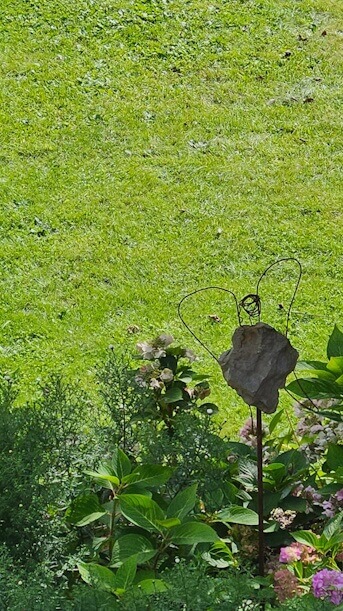
The cutting pattern of the Mammotion Luba
The cutting height of the Luba robotic mower ranges from 30 to 70 mm, falling within a typical range, and can be individually adjusted for each lawn area through the app. With an adapter, this cutting height could be further reduced to 15 mm, which poses no problem for the powerful mowing motors even in dense or tall grass. The competition from Segway or Husqvarna doesn’t allow this due to the lower voltage of 18 volts; their motors shut down under excessive load.
However, the cutting width is exceptionally wide at 400 mm, as two cutting discs under the Luba operate, each with four freely swinging blades. A lateral collision protection over the cutting discs has been added to the new Luba models to prevent the blades from hitting, for example, large uneven areas or high curbstones. While the cutting discs themselves are freely swinging in height, there is no “Floating Cut” function that adjusts the cutting discs’ height according to the terrain. In our test, we didn’t miss this feature.
The battery capacity is 4.5Ah for the smallest model and 10Ah for the two larger ones. This allows the Luba to work continuously for 2 hours or 3 hours before returning to the charging station. It does so with sufficient remaining capacity to ensure it reaches the station. A charging cycle takes approximately 3 hours for the 10Ah battery, but it won’t fully charge if a started mowing operation hasn’t been completed. The Luba operates at a voltage of just under 22 volts, significantly higher than the usual 18 volts, providing it with substantial power.
Regarding sensors, the Mammotion Luba is equipped with the standard collision sensor at the front and also has two lateral collision sensors. Additionally, it has four ultrasonic sensors oriented forward and to the sides. A rain sensor on the top interrupts or prevents the operation in case of rain. However, this can be deactivated in the app, although it’s generally not recommended. At the rear, there’s a “key” that can be removed and serves as an anti-theft measure. Additionally, there is said to be an alarm if the Luba is taken off the property without authorization. The user is then informed about the current position.
The Functions of the Mammotion Luba in Overview:
- Suitable for up to 0.25, 0.75 or 1.25 acres
- Maximum slope of 65% or 75%
- Powerful and reliable all-wheel drive
- Virtual perimeter wire via GPS navigation
- Multi-zone function (3, 6, or 10 zones)
- Cutting height from 30 to 70 mm – freely selectable for each lawn area
- Cutting width of 400 mm through two cutting discs
- Battery capacity of 4.5 or 10Ah (2 or 3 hours of mowing time)
How does the Mammotion Luba work?
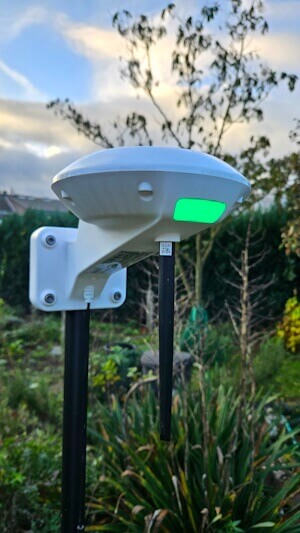
The GNSS-RTK antenna of the Luba
The Mammotion Luba operates using GPS navigation technology known as RTK, which stands for “Real-Time Kinematic.” This eliminates the need for laying a perimeter wire to define the mowing area. Consequently, it falls into the category of RTK robotic lawn mowers. This technology has traditionally been used extensively in agricultural machinery like tractors. It’s technically intricate and ideally offers precision down to 1–2 cm. Many of the latest robotic lawn mowers without perimeter wires employ this technology.
For real-time, precise positioning, the Mammotion Luba requires two GNSS receiver antennas, and a connection to at least 5 GNSS satellites simultaneously is necessary. The more satellites in the reception area, the more accurate the positioning. The robotic mower operates and initiates its mowing cycle only when a sufficient number of satellites are in range. The two GNSS receivers are integrated into both the provided antenna and the robotic mower itself.
In practice, there was never a situation where there weren’t enough satellites available to initiate the mowing process. Only in narrow areas close to buildings or directly under trees with dense canopies did occasional failures and reception issues occur. Very practical: The RTK antenna doesn’t have to be at the same location as the charging station. Both can be installed and powered separately. To our knowledge, this is unique in the class of RTK robotic mowers. Having a Wi-Fi connection throughout the entire garden is not mandatory. Only at the station for setting up the mowing process does it require an active Wi-Fi access.
The Luba AWD is suitable for multiple lawn sections and can skip areas, allowing, for example, flower meadows to be preserved for insects and other animals. A very sensible feature, in our opinion.
The test garden and requirements for operation
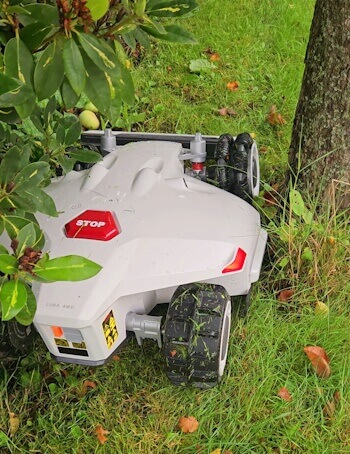
Narrow passages pose no obstacle as well
Our small test garden covers only 0,028 acres (115 m²) and is divided into four sections, which the Mammotion Luba 3000 processes in just 1 hour and 45 minutes without traveling any distance. A complete charging cycle for the Luba 3000 takes about 3 hours, and the potential continuous working time is roughly the same. If the battery falls below a certain threshold during the mowing process, the Luba will initially return to the charging station for some time and then resume its work.
The layout of our test garden is somewhat complex, including narrow passages, uneven lawn borders, large and small trees on and around the lawn, large and small hedges, a garden shed, and buildings directly adjacent to the lawn. There is also a pond in the garden that the mower should ideally avoid for cooling on hot days. Additionally, there is a section in front of the house, and the mower must travel approximately 50 meters from its station in the rear garden to reach this front area.
This route is challenging, leading from the station in the middle of the garden through a small courtyard, through a walled garden gate between the garage and the house, across a second courtyard, past a car to the lawn area in front of the house. The lawn area itself is only accessible through a very narrow passage between the hedge and the house—overall, very challenging conditions.
Configuring this route wasn’t straightforward and had to be repeated several times because satellite reception was lost in between. If the process was successfully completed, it can be tracked in the app to verify if the Luba recognized the route well enough. When zooming in on the configured route between the lawn areas on the map and identifying interruptions in the dashed line, the Luba will likely struggle or encounter problems navigating this route, and it might be necessary to recreate it.
Once it’s well-configured, and the robotic mower has sufficient satellite reception, it navigates this complex route without difficulties. While it doesn’t always work flawlessly in practice, it does so most of the time, which is fascinating to observe. It’s worth noting that the manufacturer generally doesn’t recommend using the Luba for such conditions. However, our case demonstrates that it’s still possible.
The RTK antenna covers a fairly large area and can penetrate walls, enabling the management of multiple separate lawn areas in front and behind the house. It should always have a clear view of the sky for the Luba to function seamlessly.
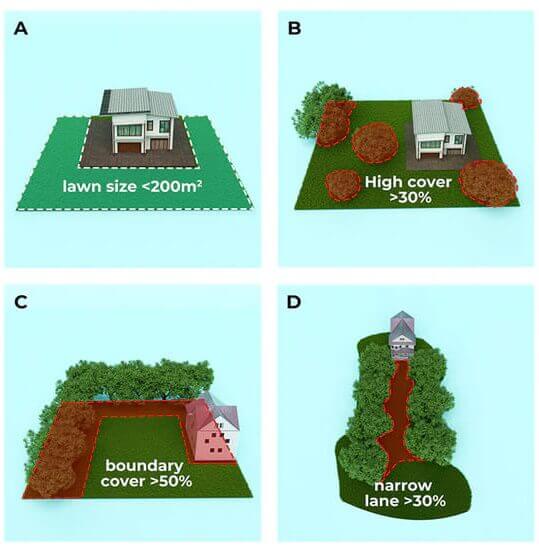
For these conditions, the Luba is officially not suitable
Here’s the official overview of the requirements for ideal GNSS-RTK reception or general conditions:
- Combined lawn areas should be at least 0,05 acres (200 m²).
- Less than 30% of the lawn area should have high walls or trees.
- The perimeter of the lawn area should be under 50% with high trees or walls.
- Less than 30% of the area should have narrow passages (less than 9.8 ft / 3 m wide and over 16 ft / 5 m long) bordered by trees or walls.
Installation, Setup, and Operation of the Luba
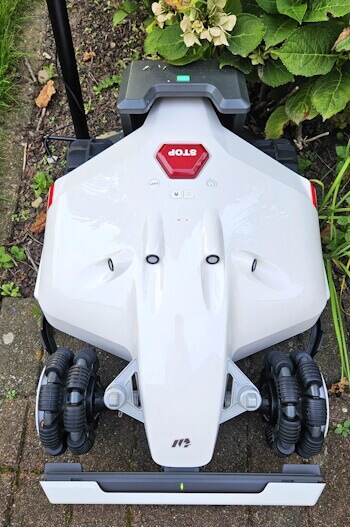
The charging station of the Mammotion Luba
The installation of the charging station and the antenna is relatively quick and self-explanatory with the provided manual and the more detailed online guide. Even as a layperson without technical knowledge or handy skills, one can manage the installation easily without any difficulties. The position of the antenna is crucial and subject to specific conditions. It should not be under trees or too close to buildings, requiring a clear sky above and around it and ideally located at the highest point on the property if there is a slope. After setup, the position of the antenna should not be changed, as the Luba orients itself based on it, and altering it would necessitate a new setup.
In practice, one quickly notices if the antenna’s position is not ideal and can adjust it accordingly. The app continuously displays the number of available satellites. If the Luba loses the signal, it typically stops and automatically reconnects. This did not occur during the mowing process in our tests but occasionally on the way to the mowing area. Moreover, more details on this will be provided later. If there’s no ideal position for the antenna within the garden, Mammotion offers an additional mounting pole*.
If an ideal position for the antenna is not possible within the garden, Mammotion offers an additional mounting pole. After pairing the device, you need to manually define the outer edges of the lawn areas by guiding the Luba along them using the app. This is done through two directional buttons in the app – forward and backward, as well as left and right, each with freely adjustable speed. The control is precise and, with a bit of practice, becomes quite intuitive. However, we would recommend installing the app on a tablet rather than a phone, although both are possible.
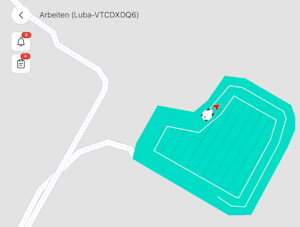
Passages connect the lawn areas
Once you’ve defined all the lawn areas, the next step is to set the paths between them so that the Luba knows where to navigate. If you’re dissatisfied with the lawn boundaries or paths during operation, adjustments can be made easily. For lawns, you can edit small sections without redefining the entire area. However, with paths, you must delete and then re-establish the entire route.
The Luba’s all-wheel-drive proved highly reliable during testing, exhibiting a robust performance. Its drive system appears robust, handling challenging conditions like uneven curbs, potholes, or even larger holes in the lawn with ease. Throughout the entire test period, there wasn’t a single instance where the Luba got stuck and couldn’t free itself. Even when confronted with a substantial pile of leaves on its path, it simply pushed it forward until an apparent electronic safety feature stopped the fun and brought it to a halt.
Based on our experience, it’s certainly suitable for gardens with significant uneven terrain or holes in the lawn. However, it’s not fond of branches, nuts, or apples on the lawn. It’s advisable to quickly scan the lawn for such obstacles before each mowing session. Otherwise, it could lead to motor overload, triggering an error message and excessive wear on the blades. In such cases, it would still continue its work, leaving neatly peeled forgotten apples in its wake.
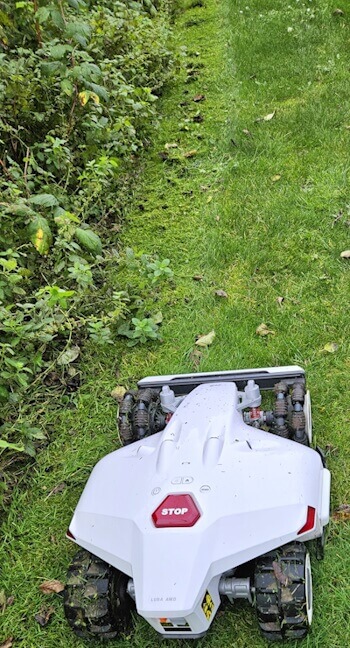
Edge mowing without issues if there is enough space
The Luba handles taller grass well due to its robust drive and mow motors. However, attention should be paid to the chosen operating mode and the “Bypass Strategy” set within it, preventing the ultrasonic sensors from identifying tall grass as obstacles. For grass over 15 cm high, the Bypass Strategy should be set to “Off,” and only when grass blades are under 7 cm should “Level 2” be selected. Opting for the “Fine” mode during the first mowing session with taller grass allows the Luba to pick up residual clippings in a second pass. The cross-mowing pattern further mulches the clippings, serving as a natural fertilizer. Mowing in straight lines leaves a well-groomed lawn, preferred over the chaotic mowing approach of many robotic mowers. The cutting performance is excellent, especially in edging, given that the Luba has space and no high curbs obstruct its path.
The precision of the Luba’s position is generally high during operation, with slight deviations occurring only in areas where reception is less than ideal. This may affect the precision of edging in these areas. Although the Luba might slightly cross the mowing area in very rare instances, it never completely leaves it. Issues can arise when maneuvering in extremely tight spaces, such as near a pond, where placing a larger stone can prevent complications.
When encountering an obstacle and triggering the bumper sensor or ultrasonic sensors, the Luba emits an audible signal and circumvents the obstacle generously, though sometimes overly so. The operational noise is minimal, making it noticeable but not causing any disturbance, which aligns with the typical behavior of robotic mowers.
During our test, the Luba attracted attention from neighbors and became a small attraction. The testing area was extended to the neighboring property, allowing the Luba to cover more ground. The Luba’s antenna has a reception radius of 120 meters, theoretically enabling shared ownership and use with neighbors, potentially dividing the purchase cost.
Table: Luba Versions Comparison
In the following table, we have compared the three different versions of Luba. Here you can quickly compare the features and differences:
| Luba AWD 1000 | Luba AWD 3000 | Luba AWD 5000 | |
|---|---|---|---|
 |  |  |
|
| Max. lawn size | Up to 0.25 ac (1000 m²) | Up to 0.75 ac (3000 m²) | Up to 1.25 ac (5000 m²) |
| Area performance | 3800 ft² / hour (350 m²) | 3800 ft² / hour (350 m²) | 5400 ft² / hour (500 m²) |
| Navigation | GPS (RTK technology) | GPS (RTK technology) | GPS (RTK technology) |
| Max. climbing ability | 65% slope (33°) | 65% slope (33°) | 75% slope (37°) |
| Max. zone management | Up to 3 zones | Up to 6 zones | Up to 10 zones |
| Cutting height | 1.18-2.76 in (30-70 mm) | 1.18-2.76 in (30-70 mm) | 1.18-2.76 in (30-70 mm) |
| Cutting width | 16 in (40 cm) | 16 in (40 cm) | 16 in (40 cm) |
| App controlled | Bluetooth, Wi-Fi | Bluetooth, Wi-Fi | Bluetooth, Wi-Fi |
| Engine | All-Wheel Drive (AWD) | All-Wheel Drive (AWD) | All-Wheel Drive (AWD) |
| Mowing time | 2 hours | 3 hours | 3 hours |
| Obstacle detection | Ultrasonic sensor | Ultrasonic sensor | Ultrasonic sensor |
| Waterproof level | IPX6 | IPX6 | IPX6 |
| Rain sensor | |||
| Collision & lift sensor | |||
| Theft protection | |||
| Price (*ad) | » Check Offer* | » Check Offer* | » Check Offer* |
The App Control of the Luba Robotic Mower
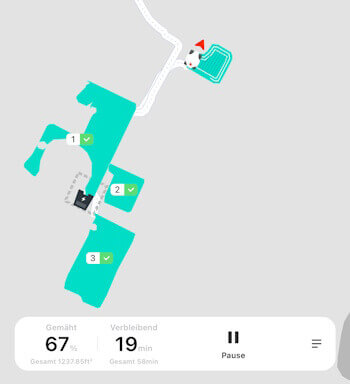
The lawn area in the app
The Mammotion app is fundamentally functional. It initially requires a bit more attention until you get used to the controls, but it’s manageable. In other words, it works without major errors and is not delivered in an immature beta status, as has been the case with some other manufacturers. However, it is still in need of improvement in terms of user-friendliness and has some missing translations depending on the selected language. For example, lawn areas are still given in square feet in the European region, and some terms are still in English. Nevertheless, after a short period of getting used to it, we are generally satisfied with the app and were able to navigate it well in our test.
After creating an account with Mammotion and logging into the app, you need to pair the device with the app. Multiple Mammotion robotic mowers can be managed with a single app. To pair and manually control the robotic mower, you always need to be near the device and have an active Bluetooth connection. It is not possible to manually control the device remotely via Wi-Fi, which the manufacturer justifies with understandable security considerations. However, for already configured lawn areas, the mowing process can be manually started remotely via Wi-Fi. Additionally, settings can be adjusted remotely via Wi-Fi, and the status of the battery, Bluetooth, Wi-Fi, and GPS connections can be checked.
After pairing, the home screen provides an overview of the battery level, Wi-Fi and Bluetooth connections, and basic settings, including a feedback function. An icon for updates, if available for the device, is also displayed (an icon with an upward arrow and a red dot). For devices of this relatively newer generation of robotic mowers without perimeter wires, this symbol should be noted. If updates are available, clicking on the update icon displays the firmware version and a description of the issues fixed—unfortunately, once again, only in English. Clicking on “Upgrade” will update the robot mower’s software.
During our several weeks of testing, there have been several updates that fixed minor issues, which we would like to highlight positively. If you are dissatisfied with certain functions during operation, it’s worthwhile to provide feedback. Especially in this fiercely competitive market of robotic mowers without boundary cables, not every detail is tested and perfected before the market launch. This is a common process for all manufacturers but should always find a healthy balance, which, in the case of the Mammotion Luba, is definitely the case. In other words, the device is delivered sufficiently refined in terms of software for this class of robotic mowers.
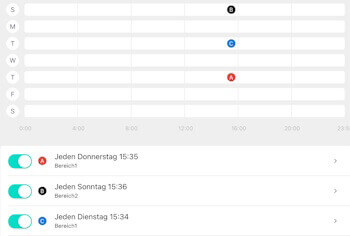
The schedule for the mowing operations
On the home screen, in the upper-left corner, there is a chronological overview of all notifications that occurred during operation. We recommend checking this area regularly to understand how the device is working and to identify any difficulties during mowing. New notifications are marked there with a red number. In addition to error messages, there is also an overview of harmless notifications, such as the start or end of work, and other messages, such as winter maintenance. All messages are clearly displayed with a timestamp, making it easy to identify them.
Mowing processes can be initiated manually or automatically controlled through a schedule. In the schedule, each subarea can be configured individually, allowing you to choose the frequency, as well as the day and time for mowing for each lawn area. Additionally, for each subarea, you can set the working mode and blade height. The working mode is particularly important for the initial mowing process and the current grass height.
In the end, there is a clear summary of the planned mowing processes for each area, and you can temporarily turn them off with a toggle switch.
Maintenance, Care, and Durability
The Mammotion Luba AWD has an IPX6 protection rating, providing “protection against powerful jets of water for at least 3 minutes” which is quite rare for robotic mowers. To our knowledge, only the Segway Navimow meets this high protection class. However, for added safety, we still recommend a robotic mower garage, which provides protection against heat and UV radiation, among other things. Nevertheless, we advise against cleaning it with a strong water jet, as you can never be sure if the seals are fully functional over time and if water can truly be kept out. There are good videos on YouTube that provide tips for cleaning.
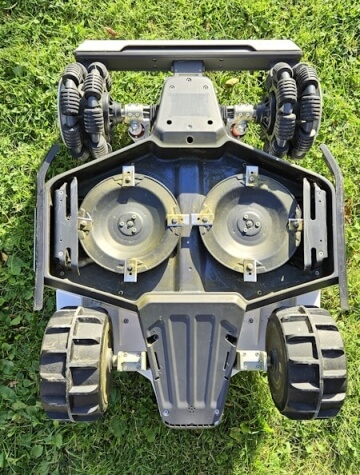
The underside of the Luba featuring two cutting discs
The RTK antenna of the Luba has a direct power supply, which offers a significant advantage over the Ecovacs model, as there is no need to regularly change batteries. For those without a power outlet in the immediate vicinity of the lawn area, an additional 10m extension cable is provided. The RTK antenna can be powered independently of the charging station and placed in an entirely different location.
If the lawn’s cutting quality deteriorates and the grass blades look frayed, it’s probably time to replace the blades. Depending on the lawn area, this should be done every 3–6 months. The first set of new blades is already included in the delivery. Before replacement, you can check if the blades are still slightly movable on the screw or if there is accumulated debris that needs to be removed. If the blades on the front side are dull, they can also be flipped before replacing them entirely.
For winter, Mammotion provides timely maintenance tips in the winter maintenance message that appears in the app. Regarding general durability, we cannot make precise statements. We consider the Luba to be durable and are satisfied with its construction.
We recommend not using the robotic mower in the rain, as wear and dirt accumulation would be higher. While mowing on wet grass is possible, grass clippings quickly accumulate on the underside of the mower, potentially affecting the mechanics of the cutting disc height adjustment. Additionally, the Luba might spread the clippings irregularly on the lawn or between the passages, preventing them from acting as a broad-spectrum fertilizer. Regarding the general durability of the Luba, we can only speculate, but would consider it to be high in comparison.
Tips & Tricks for Handling the Mammotion Luba
In this section, we’d like to briefly address typical errors and challenges during operation and how to resolve them.
- Docking at the Charging Station: In rare cases, the black area at the back of the Luba may become dirty or covered with small grass clippings, making it difficult for the mower to orient itself when docking at the charging station. Even small grass remnants can cause issues. The solution is to clean this area, both on the robotic mower and the station.
- Frequent Maneuvering: Occasionally, the Luba may deviate from its straight paths and suddenly start maneuvering excessively, often at the edge of the mowing area. This could be due to poor GPS reception or ultrasonic sensors alarming due to lateral obstacles. The solution might involve refining the virtual boundary, removing obstacles at the edge of the mowing area, or adjusting the settings in the app to prompt the mower to evade obstacles only upon physical contact.
- Recurring Bumping: If there are solid obstacles in the mowing area, the Luba may repeatedly bump into them and try to navigate around the area generously, depending on the operating mode. A solution is to insert a no-go zone so that the Luba knows to avoid this area from the outset.
- Crossing the Mowing Area: If the Luba frequently crosses the mowing area at specific spots, it’s advisable to adjust the virtual boundary to ensure more distance is maintained in that area. This adjustment can be done quickly and easily via the app without reconfiguring the entire area. Placing large stones at critical points can also help ensure that these areas are not crossed.
- Loss of Satellite Reception: If the Luba consistently loses reception to the antenna or satellites, it indicates that either the antenna’s position is not ideal or the mower itself is being obstructed by tall buildings, a roof, or trees and tall hedges. A solution involves repositioning the antenna and/or avoiding areas that are not under open sky and often lead to reception interruptions. A quick pass without major changes in direction can sometimes resolve this issue. In general, the RTK antenna and the Luba itself should ideally always have a clear view of the sky.
- Lawn Damage: In specific areas, frequent maneuvering may result in some wear and tear on the lawn, depending on its condition. The solution is to enable the “Multi-Point Turn” setting in the app. When activated, the Luba no longer rotates in place but moves forward and backward, minimizing impact on the lawn.
- The lawn edges remain standing: The mower might not mow all the way to the edge, leaving around 5 cm untouched, even though it drives directly along the edge of the lawn. This is simply due to the design and can also happen with conventional lawn mowers. The solution is straightforward: If possible, let the Luba drive slightly over the curb or lawn border. If not possible, manual touch-up work is required in those areas. Officially, Mammotion advises maintaining a distance of 10 cm from the boundary.
FAQ: Find your answers about Mammotion Luba
Here, we compile commonly asked questions and provide brief answers to each:
Conclusion of the Luba Robot Lawn Mower Test
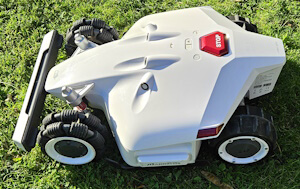
Mammotion Luba impresses in the test
The results of the test have convinced us and are impressive – there are some minor issues here and there, but overall, they are not obstacles to making a purchase. We are amazed at how a start-up can positively stand out against established robotic mower manufacturers in such a short time. The quality of the construction gives us the impression of robustness and high quality, which we consider to be substantial. The design is uniquely shaped and is also very appealing to us. It’s genuinely enjoyable to watch Luba at work, and it quickly becomes an attraction in the neighborhood.
We would describe the cutting pattern and overall mowing results as nearly perfect. Mowing in straight lines leaves a well-maintained impression on the lawn. In our experience, there is room for improvement in edge mowing, but this is not always a fault of the robotic mower itself. The GPS connection is not always optimal, but this is more due to the RTK technology and its requirements than to Luba. Nevertheless, the practicality surprised us in this regard during testing, even under less than optimal conditions, exceeding our expectations overall. The app is functional, but could be improved in a few areas.
The standout features in the category of RTK robotic mowers are the robust all-wheel drive with high off-road capability, the self-powering of the antenna for a location separate from the charging station, and the large cutting width. All in all, at this point, we can clearly recommend a purchase. If this changes in the course of further operation, we will certainly add and clearly state this in this review.
Video: Review & Experience with the Mammotion Luba 2024
Images: © Mammotion


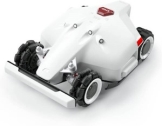


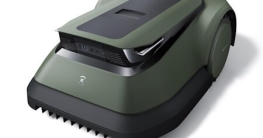
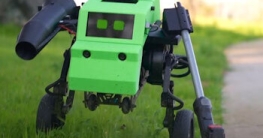
Comments
Borje 21. February 2024 at 15:11
Hi, there is a mismatch in climbing data between mammotion.com/pages/luba-2-awd-series, they are all 80/38 and your Max. climbing ability 65% slope (33°) 65% slope (33°) but differs in model 5000 75% slope (37°) pls.comment
robot-lawn-mower.net 4. March 2024 at 23:19
Hey Borje, thanks – indeed there is a difference. This review was about the Luba 1 and the page you sent showed the Luba 2. We will very soon add a direct comparison table here for Luba 1 vs. Luba 2. However, the Luba 2 has 80% max. climbing ability and the Luba 1 has 65% (or 75% on the luba 1 5000).